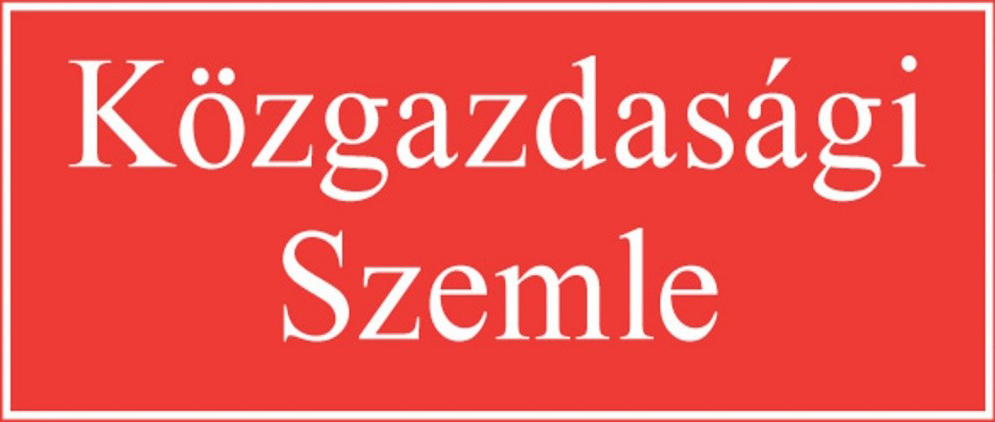Mekkora az államadósság terhe?
Az államadósság hatása a gazdasági növekedésre a neoklasszikus növekedéselméletben
Absztrakt
A tanulmány az államadósság hosszú távú egyensúlyi jövedelmekre gyakorolt hatását vizsgálja a neoklasszikus növekedéselmélet keretében. Az államadósságot két alapvető neoklasszikus modellbe építjük be – a Ramsey–Cass–Koopmans-féle, illetve a Solow-féle modellbe –, amely modellek csak a háztartások megtakarítási viselkedésére adott feltevésekben különböznek egymástól. Ezen túlmenően kidolgozunk egy olyan általános modellt is, amely a háztartások megtakarítási magatartására vonatkozó feltevésektől függetlenül képes az államadósság terhének számszerűsítésére. Eredményeink egyfelől azt mutatják, hogy az államadósság okozta kibocsátásveszteséget a költségvetési deficit beruházásokat kiszorító hatásának mértéke erőteljesen befolyásolja. Másfelől, az államadósság terhe országspecifikus, amelyet a magánszektor megtakarítási rátája és a népesség növekedési üteme határoz meg. Következtetéseink alapján az államadósság terhe a fejlett országokban még jelentős kiszorítási hatás esetén is meglehetősen kicsi. Mindez azt jelenti, hogy az európai uniós országokban önmagában az államadósság lefaragásától a jövedelemszint jelentős emelkedése és a gazdaságok gyors növekedése nem remélhető.
Hivatkozások
ACEMOGLU, D. [2009]: Introduction to Modern Economic Growth. Princeton University Press, Princeton, NJ.
AUERBACH, A. J.–GORODNICHENKO, Y. [2012]: Fiscal Multipliers in Recession and Expansion. Megjelent: Alesina, A.–Giavazzi, F. (szerk.): Fiscal Policy after the Financial Crisis. National Bureau of Economic Research, 63–98. o. https://doi.org/10.7208/chicago/9780226018584.003.0003.
BALL, L.–MANKIW, N. G. [1995]: What Do Budget Deficits Do? NBER Working Paper, No. 5263. National Bureau of Economic Research, Cambridge, MA.
BARRO, R. J. [1974]: Are Government Bonds Net Wealth? Journal of Political Economy Vol. 82. No. 6. 1095–1117. o. https://doi.org/10.1086/260266.
BARRO, R. J.–SALA-I-MARTIN, X. [2004]: Economic Growth. 2. kiadás. The MIT Press, Cambridge, MA.
BELL, A.–JOHNSTON, R.–JONES, K. [2015]: Stylised Fact or Situated Messiness? The Diverse Effects of Increasing Debt on National Economic Growth. Journal of Economic Geography, Vol. 15. No. 2. 449–472. o. https://doi.org/10.1093/jeg/lbu005.
BERNHEIM, B. D. [1987]: Ricardian Equivalence: An Evaluation of Theory and Evidence. Megjelent: Fischer, S. (szerk.): NBER Macroeconomics Annual. Vol. 2. MIT Press, Cambridge, MA, 263–304. o.
BLANCHARD, O. J. [1985]: Debt, Deficits, and Finite Horizons. Journal of Political Economy, Vol. 93. No. 2. 223–247. o. https://doi.org/10.1086/261297.
BLANCHARD, O. J.–LEIGH, D. [2013]: Growth forecast errors and fiscal multipliers. American Economic Review: Papers & Proceedings, Vol. 103. No. 3. 117–120. o. https://doi.org/10.1257/aer.103.3.117.
CAROLL, C. D.–SUMMERS, L. H. [1991]: Consumption Growth Parallels Income Growth: Some New Evidence. Megjelent: Bernheim, B. D.–Shoven, J. B. (szerk.): National Saving and Economic Performance. University of Chicago Press, Chicago, 305–348. o.
Cass, D. [1965]: Optimum Growth in an Aggregative Model of Capital Accumulation. The Review of Economic Studies, Vol. 32. No. 3. 233–240. o.
CECCHETTI, S. G.–MOHANTY, M. S.–ZAMPOLLI, F. [2011]: The real effects of debt. Bank for International Settlements, BIS Working Papers, No. 352. https://www.bis.org/publ/work352.pdf.
CHECHERITA-WESTPHAL, C.–ROTHER, P. [2012]: The Impact of high government debt on economic growth and its channels: an empirical investigation for the euro area. European Economic Review, Vol. 56. No. 7. 1392–1405. o. https://doi.org/10.1016/j.euroecorev.2012.06.007.
DEDÁK ISTVÁN–DOMBI ÁKOS [2018]: A Closed-Form Solution for Determining the Burden of Public Debt in Neoclassical Growth Models. Bulletin of Economic Research, Vol. 70. No. 1. 88–96. o. https://doi.org/10.1111/boer.12125.
DIAMOND, P. A. [1965]: National Debt in a Neoclassical Growth Model. The American Economic Review, Vol. 55. No. 5. 1126–1150. o.
DOMBI ÁKOS–DEDÁK ISTVÁN [2019]: Public debt and economic growth: what do neoclassical growth models teach us? Applied Economics, Vol. 51. No. 29. 3104–3121. o. https://doi.org/10.1080/00036846.2018.1508869.
EBERHARDT, M.–PRESBITERO, A. F. [2015]: Public Debt and Growth: Heterogeneity and Non-Linearity. Journal of International Economics, Vol. 97. No. 1. 45–58. o. https://doi.org/10.1016/j.jinteco.2015.04.005.
ÉGERT BALÁZS [2015]: The 90% Public Debt Threshold: The Rise and Fall of a Stylized Fact. Applied Economics, Vol. 47. No. 34–35. 3756–3770. o. https://doi.org/10.1080/00036846.2015.1021463.
EGGERTSSON, G. B.–KRUGMAN, P. [2012]: Debt, Deleveraging, and the Liquidity Trap: A Fisher–Minsky–Koo Approach. Quarterly Journal of Economics, Vol. 127. 1469–1513. o. https://doi.org/10.1093/qje/qjs023.
ELMENDORF, D. W.–MANKIW, N. G. [1999]: Government Debt. Megjelent: Taylor, B.–Woodford, M. (szerk.): Handbook of Macroeconomics. Elsevier, Amszterdam, Vol. 1. 615–1669. o.
HAYO, B.–NEUMEIER, F. [2017]: The (In)Validity of the Ricardian Equivalence Theorem – Findings from a Representative German Population Survey. Journal of Macroeconomics, Vol. 51. 162–174. o. https://doi.org/10.1016/j.jmacro.2017.01.003.
HERNDON, T.–ASH, M.–POLLIN, R. [2013]: Does High Public Debt Consistently Stifle Economic Growth? A Critique of Reinhart and Rogoff. Cambridge Journal of Economics, Vol. 38. No. 2. 257–279. o. https://doi.org/10.1093/cje/bet075.
JOHNSON, D. S.–PARKER, J. A.–SOULELES, N. S. [2006]: Household Expenditure and the Income Tax Rebates of 2001. American Economic Review, Vol. 96. No. 5. 1589–1610. o. https://doi.org/10.1257/aer.96.5.1589.
KOOPMANS, T. C. [1965]: On the Concept of Optimal Economic Growth. Megjelent: Johansen, J. (szerk.): The Econometric Approach to Development Planning. North Holland, Amszterdam, 225–287. o.
KUMAR, M. S.–WOO, J. [2010]: Public debt and growth. International Monetary Fund, Working Paper, No. 174.
MANKIW, N. G. [1995]: The Growth of Nations. Brookings Papers on Economic Activity, 1. 275–326. o. https://scholar.harvard.edu/files/mankiw/files/growth_of_nations.pdf.
MANKIW, N. G. [2000]: The Savers-Spenders Theory of Fiscal Policy. American Economic Review, Vol. 90. No. 2. 120–125. o. https://doi.org/10.1257/aer.90.2.120.
MANKIW, N. G.–ROMER, D.–WEIL, D. N. [1992]: A Contribution to the Empirics of Economic Growth. The Quarterly Journal of Economics, Vol. 107. No. 2. 407–437. o.
MELLÁR TAMÁS [2002]: Néhány megjegyzés az adósságdinamikához. Közgazdasági Szemle, 49. évf. 9. sz. 725–740. o.
PUENTE-AJOVÍN, M.–SANSO-NAVARRO, M. [2015]: Granger Causality between Debt and Growth: Evidence from OECD Countries. International Review of Economics & Finance, Vol. 35. 66–77. o. https://doi.org/10.1016/j.iref.2014.09.007.
RAMSEY, F. P. [1928]: A Mathematical Theory of Saving. The Economic Journal, Vol. 38. No. 152. 543–559. o.
REINHART, C. M.–ROGOFF, K. S. [2010]: Growth in a Time of Debt. American Economic Review, Vol. 100. No. 2. 573–577. o. https://doi.org/10.1257/aer.100.2.573.
ROMER, D. [2012]: Advanced Macroeconomics. 4. kiadás. McGraw-Hill, New York.
SHAPIRO, M. D.–SLEMROD, J. [2003]: Consumer Response to Tax Rebates. American Economic Review, Vol. 93. No. 1. 381–396. o. ttps://doi.org/10.1257/000282803321455368.
TAMBORINI, R.–TOMASELLI, M. [2020]: When does public debt impair economic growth? A literature review in search of a theory. DEM Working Papers 2020/7. Department of Economics and Management.
TÓTH G. CSABA [2012]: Debt Dynamics and Sustainability. Hungarian Statistical Review, Vol. 90. No. 16. 123–149. o.
WOLF, M. [2012]: Getting out of Debt by Addig Debt. The Financial Times, http://blogs.ft.com/martin-wolfexchange, július 25.







